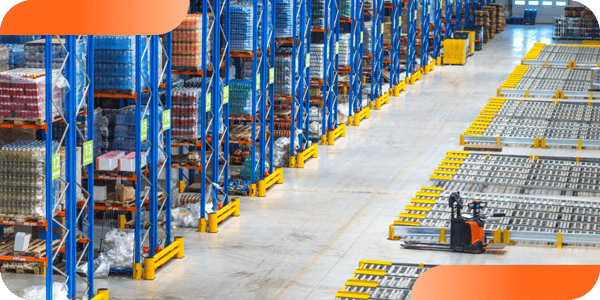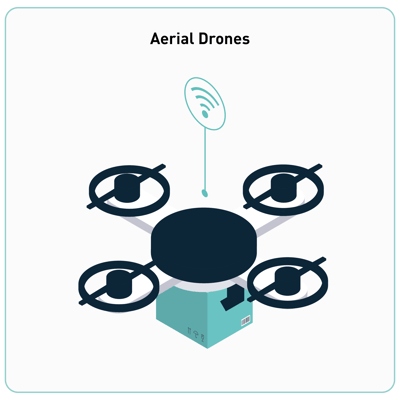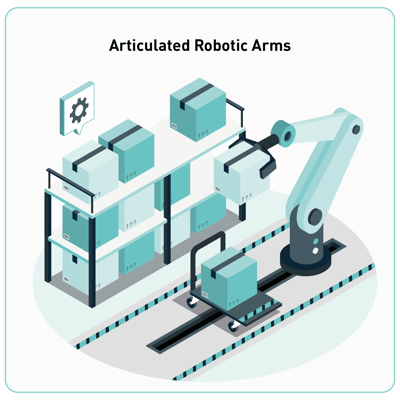Warehouse, Picking
Unlocking Efficiency: The Role of Warehouse Robotics in Reshaping Modern Commerce

In the dynamic landscape of modern commerce, the convergence of e-commerce and omnichannel fulfillment has reshaped how businesses operate. The traditional paradigms of brick-and-mortar stores have given way to a new era where seamless online shopping experiences and efficient order fulfillment are paramount. At the heart of this transformation lies the integration of warehouse robotics. This technological revolution streamlines essential warehouse tasks and holds the key to unlocking unparalleled efficiency and scalability.
As businesses grapple with the challenges posed by the dynamic nature of omnichannel fulfillment, understanding the pivotal role of warehouse robotics becomes imperative. This article delves into the multifaceted world of robotics, exploring its definition, its transformative impact on omnichannel warehousing, the diverse types of robotics reshaping the industry, the myriad benefits it offers, and, ultimately, the profound implications for the future of warehousing. Join us on a journey through the intricacies of robotics in fulfillment, where innovation meets practicality to redefine the very essence of modern supply chain management.
What is Warehouse Robotics?
In the ever-evolving landscape of modern commerce, the integration of warehouse robotics stands as a cornerstone for redefining fulfillment processes. Warehouse robotics, a subset of automation, involves using autonomous machines and specialized software to streamline essential warehouse tasks. These robotic systems have evolved to address the challenges of omnichannel fulfillment, offering efficiency, precision, and scalability.
As traditional retail models give way to e-commerce and omnichannel strategies, the role of robotics in warehousing becomes increasingly crucial. The demand for seamless and efficient order fulfillment has led to a reliance on automation. The benefits are multifaceted: automated order picking, reduced travel time and labor, sorting and packaging, inventory management, warehouse optimization, scalability, flexibility, and the invaluable insights derived from data analytics.
Warehouse robotics is not merely a trend but a transformative force in omnichannel fulfillment. As industries evolve and customer expectations rise, embracing the benefits of warehouse robotics becomes not just an option but a necessity for businesses looking to thrive in the years to come. The future of warehousing is undeniably intertwined with the evolution of robotics, offering safer, faster, and more efficient operations.
The Role of Robotics in Omnichannel Warehousing
In the ever-changing terrain of omnichannel warehousing, where customer expectations continue to shape the industry, robotics is pivotal in elevating operational efficiency. The traditional boundaries between brick-and-mortar establishments and e-commerce are fading, leading to a seamless integration of various channels. This transformation demands heightened agility and precision in fulfillment strategies, pushing businesses to explore innovative solutions to navigate the intricacies of modern order fulfillment.
Within this dynamic scenario, the significance of robotics becomes increasingly apparent. It is a versatile solution to the challenges of smaller order profiles and intricate picking strategies that characterize omnichannel operations. Automation, mainly through robotics, addresses critical aspects such as automated order picking, reduced travel time and labor, sorting and packaging optimization, and efficient inventory management. The capacity to scale operations seamlessly and adapt to fluctuating demands positions robotics as an essential cornerstone for successful omnichannel fulfillment.
Industry insights further emphasize that integrating robotics is not a universal remedy but a strategic tool to address specific challenges within a warehouse operation. This strategic implementation aligns with the overarching goal of accurately and cost-effectively fulfilling various orders. In essence, robotics becomes a means to an end, enabling businesses to objectively compare and select the most effective solution tailored to their unique requirements. As we delve into the intricacies of the omnichannel landscape, robotics emerges not just as a technological innovation but as a guiding force, paving the way for a more seamless and responsive fulfillment experience.
Types of Warehouse Robotics
Warehouse robotics is characterized by specialized machines designed to revolutionize various facets of warehouse operations. These robots and advanced control software contribute to the efficiency and precision required in modern fulfillment processes. Let's delve into the diverse types of warehouse robotics that are reshaping the logistics landscape:
Automated Guided Vehicles (AGV):
AGVs act as autonomous mobile transport units within a warehouse. Unlike traditional forklifts or pick carts that require human drivers, AGVs navigate using embedded markers or advanced LiDAR technology. This navigation capability allows them to move seamlessly through the warehouse, enhancing efficiency in material transportation.
.png?width=400&height=322&name=Automated%20Guided%20Vehicles%20(AGV).png)
Autonomous Mobile Robots (AMR):
AMRs, equipped with sensors such as LiDAR, infrared, or onboard cameras, navigate warehouses autonomously. Unlike AGVs, AMRs have the flexibility to create routes, resulting in significant efficiency gains. They can intelligently maneuver around obstacles, ensuring continuous workflow.
.png?width=400&height=400&name=Autonomous%20Mobile%20Robots%20(AMR).png)
Aerial Drones:
Flying drones, capable of high-speed movement and accessing confined spaces, find utility in tasks like inventory scanning. They can fly to specific slots, estimate material quantities, and automatically update the inventory management system, contributing to accurate and real-time inventory control.

Crewless Aerial Vehicles (UAV):
Similar to aerial drones, UAVs perform tasks under human operator control. These robots, which are controlled remotely, provide an additional layer of flexibility and can assist in various warehouse activities.
.png?width=400&height=318&name=Crewless%20Aerial%20Vehicles%20(UAV).png)
Automated Guided Carts (AGC):
AGCs are akin to AGVs but are designed to carry smaller loads of material. They operate autonomously and contribute to efficiently moving smaller quantities within the warehouse.
.png?width=400&height=318&name=Automated%20Guided%20Carts%20(AGC).png)
Automated Storage & Retrieval Systems (AS/RS):
AS/RS robots, often moving on fixed tracks, use cranes or lifters to navigate warehouse aisles. These robots are particularly adept at retrieving products from various locations within the warehouse and are commonly used alongside Warehouse Management Systems (WMS).
.png?width=400&height=400&name=Automated%20Storage%20%26%20Retrieval%20Systems%20(ASRS).png)
Collaborative Robots (Cobots):
Cobots bridge the gap between complete autonomy and human control. Programmed to collaborate with human workers, some follow workers as they pick orders, while others operate autonomously in areas where humans are also present. Advanced sensors mitigate the risk of collisions, ensuring a safe working environment.
.png?width=400&height=305&name=Collaborative%20Robots%20(Cobots).png)
Articulated Robotic Arms:
These robots, often mounted on wheeled bases for mobility, consist solely of articulated arms. Their applications range from picking and packing to assembling components, unloading containers, and constructing pallets.

Goods-to-Person (G2P):
G2P robots eliminate the need for employees to travel to shelves for item retrieval. Instead, these robots transport items directly to the picking stations, streamlining the order fulfillment process.
.png?width=400&height=400&name=Goods-to-Person%20(G2P).png)
Exploring these diverse types of warehouse robotics showcases the versatility and innovation driving the transformation of traditional warehousing into dynamic, automated ecosystems. Each class caters to specific functions, contributing collectively to the evolution of efficient and responsive warehouse operations.
Benefits of Warehouse Robotics
The integration of warehouse robotics brings many advantages that significantly impact modern warehouse operations' efficiency, safety, and overall success. As businesses navigate the complexities of omnichannel fulfillment, adopting robotics emerges as a strategic imperative, offering transformative benefits. Here are key advantages associated with the incorporation of warehouse robotics:
-
Improved Worker Safety:
Warehouse robots play a crucial role in lifting heavy objects and minimizing the need for workers to cover extensive distances on foot. This enhances workplace safety and reduces the risk of repetitive stress injuries associated with manual labor.
-
Increased Productivity:
By automating various tasks, warehouse robots facilitate the swift movement of inventory into centralized areas for picking. This streamlines the assembly of pallets or individual orders, leading to heightened productivity and faster fulfillment processes.
-
Optimized Storage:
Certain robots excel in storing and retrieving inventory, often by physically moving warehouse shelves. This optimization allows for the packing of shelves in closer proximity, thereby maximizing storage space within the warehouse.
-
Automated Replenishment:
Robots contribute to the repetitive aspects of replenishing inventory by autonomously moving stock from buffer areas to warehouse slots. This automation ensures that human workers can allocate more time to critical tasks such as order picking and packing.
These benefits collectively position warehouses with a robotics infrastructure at a competitive advantage. As the demand for faster, more accurate order fulfillment continues to intensify, the role of robotics extends beyond mere automation—it becomes a catalyst for fostering a safer, more productive, and innovative warehouse environment.
In conclusion, the landscape of warehouse robotics stands as a testament to the transformative power of automation in modern supply chain management. As businesses strive to meet the evolving demands of omnichannel fulfillment, the strategic integration of robotics emerges as a pivotal solution. From the versatility of Automated Guided Vehicles (AGVs) to the precision of Collaborative Robots (Cobots), the diverse array of warehouse robotics types reshapes traditional warehousing into dynamic, automated ecosystems.
The benefits of improved safety, increased productivity, optimized storage, and automated replenishment appeal underscore the strategic imperative of embracing warehouse robotics. As we move forward into a future where efficiency and responsiveness are paramount, the symbiotic relationship between human workers and robotic counterparts will continue to define the success of warehouse operations, fostering innovation and ensuring a seamless fulfillment experience. Warehouse robotics signifies a technological advancement and serves as a cornerstone for a new era in warehousing, where efficiency, safety, and agility converge to meet the demands of an ever-evolving industry.
Follow us on LinkedIn to stay informed!

Carlos Diaz
I have a BSc in Industrial Engineering from Tecnologico de Monterrey and a MSc in Financial Engineering and Risk Management from Imperial College London. I enjoy writing about the issues I’ve helped my clients solve over my almost 20 years’ experience as a supply chain consultant.


